

About the Coins
Art (Info)
Some Sources of Artistic Inspiration
Adaptations from Greek Coins
The most well-known example of adaptation of a Greek design occurred on the Large Flan Type staters and their derivatives. The Greek prototype, the Philippus, a gold stater of Philip II of Macedon, minted 559-536 B.C., was used widely as a trade coin throughout the Classical world. Two theories account for the adoption of this type by the Celts.
The first suggests that Celtic mercenaries, returning from wars during the early Third Century in Greece brought these coins back as military payment or booty. Strabo's account in which the Tectosages returned to Gaul with enormous amounts of plunder from the sack of Delphi in 279-278 B.C. supported this idea.
The second explanation is that the source of inspiration is Massalia. The Greek colony founded near the mouth of the Rhone in the Sixth Century B.C. used these coins to trade with the neighbouring Celtic tribes. The Romans, who occupied Southern Gaul in the Second Century B.C., continued to use the Philippus because it was readily accepted. The Celts were trading iron and tin in exchange for luxury goods with the traders at Massalia. Thus, by this account, the Philippus reached the Celts via the Massalia-Rhone trade route. Probably, each of these accounts was to some extent true, and the Philippus reached Gaul by both methods. In any event, there is no question the Macedonian staters reached northern Gaul by the Second Century B.C.
The Philippus became the preferred coin of the Celtic tribes because of its familiarity, and when they began to strike their own, they naturally chose the Philippus as the model. The earliest Celtic staters struck in Gaul, the predecessors to the Large Flan Type, are closer in style to the Greek originals in appearance. As time went on, the designs on both sides of the coin became increasingly abstract and expressionistic. By the time the Large Flan Type was produced the original designs were barely recognizable, having been totally transformed into Celtic motifs.
The Greek coinage of Massalia, itself; became the inspiration for yet another series of British coins. The colony had issued a series of cast bronze coins for much of the Second Century, B.C., carrying a head of Apollo on the obverse and a charging bull on the reverse. These coins traveled into the Celtic lands and eventually found their way to Britain. The Massaliot originals have been found at Richborough and Canterbury, and evidently served as prototypes for the Kentish Cast Bronze coins.
In the past, it has been suggested the Gallic tribes adopted the Massaliot designs and the British tribes then adopted the Gallic coins as models. However, recent finds of very early Kentish bronzes show them to be closer to the Greek originals than the Gallic pieces. Furthermore, the early Kentish pieces have been dated as early as 100 B.C. by archaeological finds and thus predate the Gallic issues. Consequently, it is now believed the Kentish tribes were inspired directly by the Greek prototypes.
Although the earliest Celtic designs were adopted from the Greek trading coins of the day, this was not to be the only source of inspiration. As the First Century B.C. progressed, Roman coins became much more common in the Celtic lands. Thus by mid century, the Celts began to adopt Roman types for their coins and this trend accelerated in Britain after the Gallic War.
Adaptations from Roman Coins
The first British coins with Roman themes appeared about the time of the Gallic War. An early instance was the appearance of design elements from Helmeted Roma' denarii on the Whaddon Chase Type staters (90). The wing from the helmeted head and the "X" mark of value from these Republican pieces appear on the reverse of the Celtic staters. The wing was now a free-floating object above the horse and the "X" appeared behind the animal. Surprisingly, the two objects were engraved in the proper sizes and relationship, as if they were copied directly, but with no regard to the other design elements of the denarius. The horse on this type was also Romanized to a great extent and was no longer so abstract.
About the same time, the Corieltauvi began striking silver coins, and chose the speared boar design on the denarii of C. Hosidius C. f. Geta for the reverse (91). The boar received a completely Celtic treatment, but the adaptation of the design in detail is obvious when the two types are seen side-by-side.
About the end of the war, or shortly thereafter, gold quarters staters were struck in the south of Britain, with the design adapted from the Trophy denarii of Caesar. The designs from two different Trophy denarii were adapted for two distinct varieties of quarter stater, the differences being in the details of the trophy.
These are only three examples of Roman influence on the British uninscribed coinage. Other examples undoubtedly exist, as yet undetected, offering a potentially fruitful area for discovery. The circulation of Roman coins in Britain during the Gallic War may be better understood if additional examples can be identified.
Roman Influences after the Gallic War
The Celts adapted Roman types with increasing frequency after the war, especially on the silver and bronze issues (92). By the time of Tasciovanus, Roman culture had made an impression on the nobility of several southern tribes and consequently they modified their traditional artistic style. At times, the die-cutters simply copied Roman motifs, with no attempt to Celticize them. The abstraction which previously had made Celtic coins so striking was now, in isolated instances, forsaken. Gradually, more and more designs were rendered in a Classical style. At first, this might be interpreted as reduced cultural vitality amongst the effected tribes. Whether it actually indicates a decline is worth further study.
While the reluctance of the more conservative tribes, such as the Dobunni and Corieltauvi, to accept Romanizing influences could be seen as a sign of strength, it may mean nothing more than stagnation. Stagnation was not the case for the Trinovantes/Catuvellauni and Atrebates/Regni/Belgae who were experiencing rapid change in their economies and social structures. The growth of large civil settlements in the southern tribal territories and the expanding trade with the continent are two indicators of the dynamic changes. By assimilating Roman artistic motifs, the southern tribes demonstrated a cultural transformation was taking place as well.
Although the instances of copying are dramatic ones, the majority of the die-cutters did not slavishly copy the Roman designs, but transformed them into Celtic motifs. instead. Thus, while acknowledging the 'modern', they retained the best from their own traditions. On balance, the acceptance of Romanizing influences suggests a dynamic and vigorous culture amongst the southern tribes.
Next Section – Inscriptions
